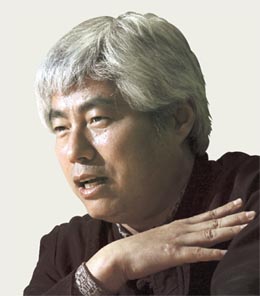Artist illuminates elegant contradictions in traditional dance

Jin Ok-sub
Jin featured many of these artists in a two-volume book he wrote on traditional Korean dance called “Noreummachi” in 2007.
Jin is perhaps best known among the general public as a choreography consultant for the 2005 blockbuster “The King and the Clown.” Through this and a number of critically acclaimed performance works, many of which feature dance masters, he has revived interest in traditional dance among a new generation of dance lovers. He is currently the artistic director of Korea Cultural House, whose mission is to preserve and promote traditional Korean culture through regular performances and workshops on performing, folk and visual arts.
Later this month, Jin will offer his insight into traditional Korean dance in a four-part lecture series at KCH called “Pungnyu [high art] and Hwaryu [low art] in the Humanities,” which examines the convergence of high and low art in traditional dance.
The JoongAng Ilbo met up with Jin to talk about the lecture series and his views on traditional dance in contemporary Korea.
Q. What motivated you to start this lecture series?
A. Dance is an art that is instantaneous. Once a performance is over, it evaporates. So I wanted to solidify traditional dance by converting it into language through these lectures and share with others the feeling of catharsis I experience whenever I watch traditional dance. Although the public’s desire to understand what art is trying to convey has increased, their desire to understand the meaning of traditional dance has decreased in comparison. And the fact that the masters of traditional dance will eventually disappear prompted me to start this lecture series in order to preserve the origins of traditional dance.
What were you trying to imply by using “pungnyu” in the title of your lecture series?
Moon Jang-won, a folk dance master, used to say, “I coordinate dance to teach my pupils and I never engage in despicable acts like receiving money for teaching them how to dance.” To him, dance was an innate part of life. This sentiment is deeply embedded in Korean traditional dance. As a result, there are no official guidelines or textbooks for learning the delicate gestures and motions of the dance. As a result, traditional dance became rather inconsistent. In this context, pungnyu implies a desire to maintain the elegance of Korean traditional dance while restoring its true nature.
What about “hwaryu”?
Jo Gap-nyo (88-years-old) and Jang Geum-do (83-years-old), who are renowned performers of (a minimalist form of Korean dance presided over by a shaman to exorcise evil spirits), may be the last surviving dancers in the genre. They learned their movements from gisaeng (female entertainers) during the Japanese occupation.
Although they learned how to dance in gisaeng houses during the occupation, they maintained their dignity. If people think that their movements were seductive and coquettish, it is just socially induced prejudice. For both of them, their dancing maintained silence and formality while exuding elegance. I think that the elements of gisaeng culture in Korean traditional dance symbolize restraint. In the old days, it was said that the two performers were so popular that you needed two rickshaws to invite them to dance. In my lectures, I plan to correct existing negative perceptions of their dancing and gisaeng culture itself and interpret it from an aesthetic point of view.
What does traditional dance mean to you?
To me, Korean traditional dance is just breathtaking. Traditional dances like pan or gut have no artificial elements and don’t require excessive breathing. Masters of dance already know how much effort it takes to perform a delicate dance without exerting a lot of energy. I think that Korean traditional dance is a reflection of the future of modern arts.
*The lecture series starts on March 28 at the Korea Cultural House in Daechi-dong, southern Seoul. The class is every Monday at 7:30 p.m. for four weeks. Tuition for the four-week class is 50,000 won ($44.40). Go to Samseong Station, line No. 2, exit 4. Call (02) 3011-1720 or visit www.kous.or.kr.
By Choi Min-woo [estyle@joongang.co.kr]










with the Korea JoongAng Daily
To write comments, please log in to one of the accounts.
Standards Board Policy (0/250자)